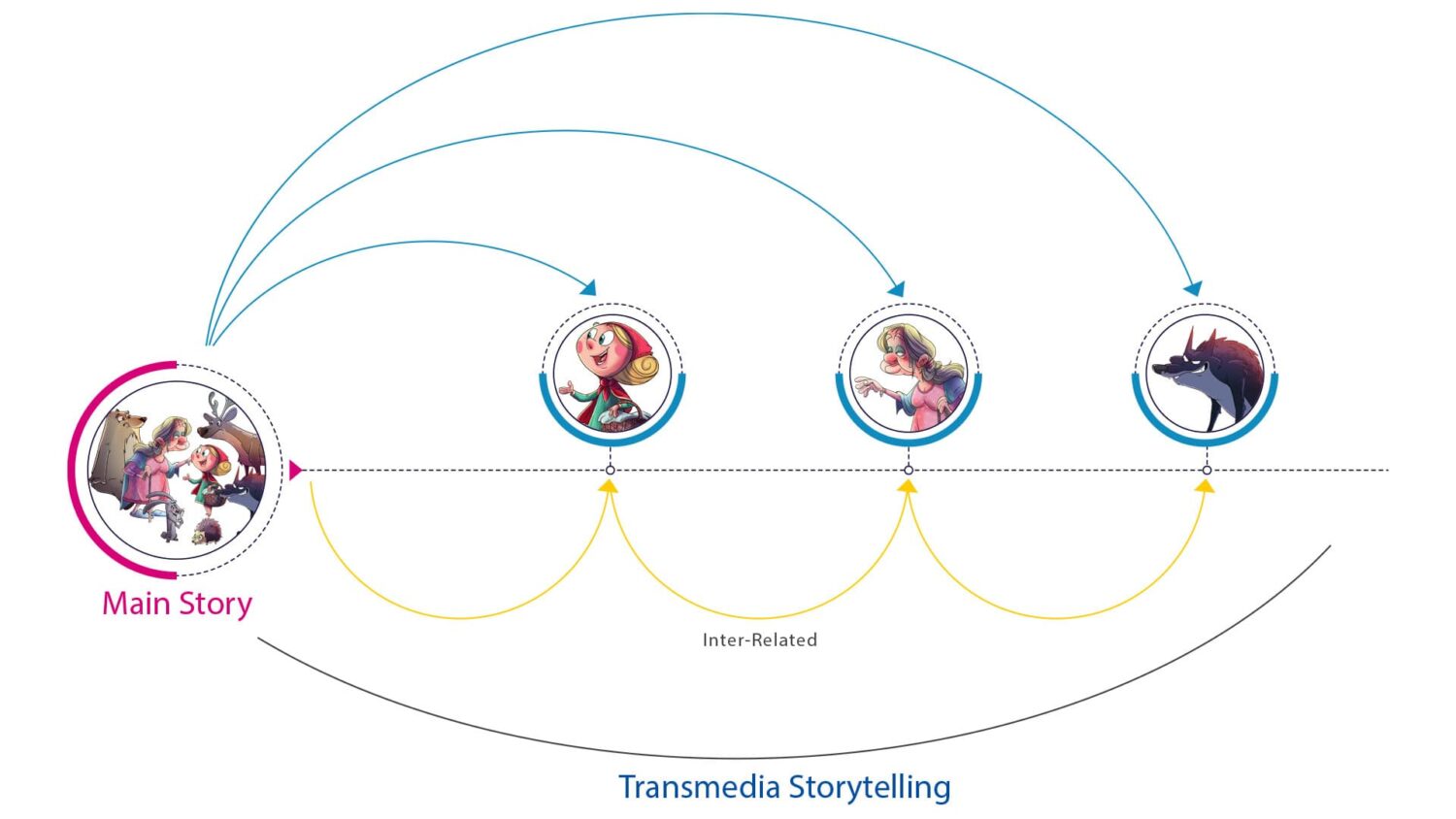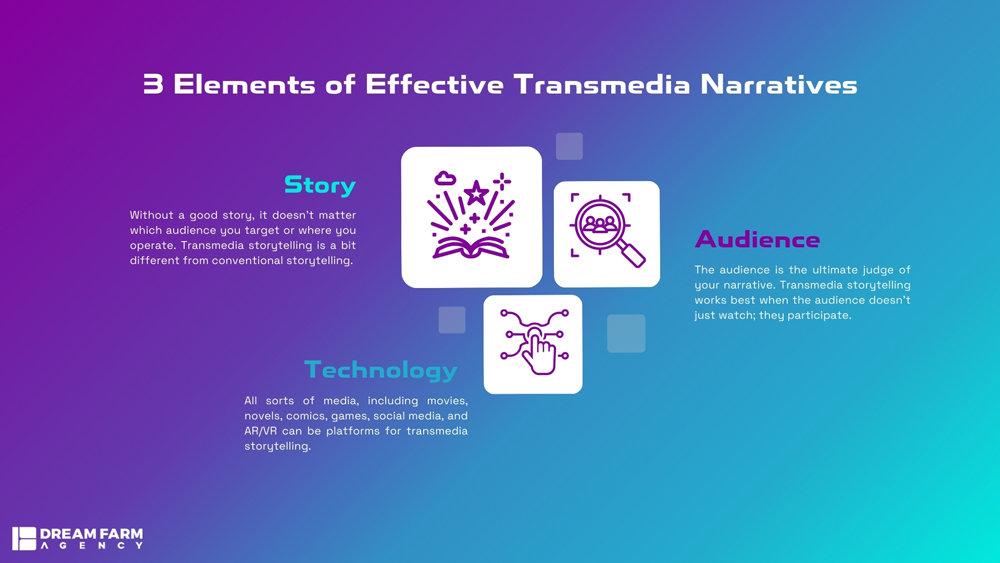
The audience is everything in a story because they judge if the story is a success or not. It doesn’t matter if the story is a novel, a movie, or a narrative that you share about your brand. You’ve probably heard that you need to define your target audience, their demographics, tastes, and needs so you can present yourself as a solution.
But, what if your target audience is a broad spectrum with different demographics and needs? What if you target both Gen Z and people well in their forties? You won’t find middle-aged groups on TikTok and Gen Z doesn’t respond as well to traditional print ads.
What is the best channel to tell your story? This is where transmedia storytelling comes in.
What is Transmedia Storytelling?
Transmedia simply means taking a story and adapting it to several different platforms, where each platform targets a different audience with different needs, mentalities, and wants. Each platform shares the narrative through a different perspective.
The biggest example is the Spiderman franchise where you get to know the superhero’s background through comic books. Then, you have the movie which targets a much wider audience and tells the story through a more visual format. Video games make the story even more immersive as the fans are not viewers anymore. They step into the world of Spiderman and become the superhero, creating a unique way for them to connect with the story.

Why Do Transmedia Storytelling?
Harry Potter, The Matrix, Game of Thrones, Lord of the Rings, and so many others have used transmedia storytelling, and it has worked for them quite well. Why?
A Bigger Net
We live in a tech-driven world where people have access to TV, social media, blogs, and books for entertainment. Everyone has a favorite medium that resonates with them. Again, using the TikTok example, just ask a 17-year-old and a 40-year-old about what they think of the platform. You’ll probably get two very different answers. They may be even the same age but with different genders or cultural backgrounds.
Instead of telling one general story for all, you want to cast a wide net and adapt your story to their favorite mediums. This is what transmedia storytelling does.
Evergreen Brand Presence
Transmedia storytelling gives you a lot of room for growth and flexibility, meaning that you can add new plots, characters, or campaigns over time to keep up with the audience’s demands and still remain relevant.
As you grow, the brand becomes more than just the product. It gives you a story that people want to be a part of. Take “Star Wars” as an example. It began as a movie, but it grew into comics, books, TV shows, and merchandise, making the brand a huge and long-lasting part of culture.
Building a Loyal Customer Base
Transmedia stories bring together groups of passionate fans who are interested in the same thing. By putting content on a lot of different platforms, you make it easier for fans to connect with each other and talk about, examine, and make their own content about the story. With its TV shows, audio plays, books, and events, the “Doctor Who” brand has built a strong and loyal fan base, creating a loyal fanbase.
Elements of Effective Transmedia Narratives
Any successful transmedia story rests on three pillars. Together, these pillars form a solid foundation for businesses to create compelling transmedia narratives.

Story
Without a good story, it doesn’t matter which audience you target or where you operate. Transmedia storytelling is a bit different from conventional storytelling. Normally, you create a single story and repeat it through different channels. But, with transmedia storytelling, you need to keep the main story but use it as a foundation for new narratives.
This means creating characters, plot points, and settings not just in one place, like a movie, but also in games, comics, or social media. For example, in the Marvel franchise, characters like Iron Man and Spiderman don’t just exist in movies; they have stories in comics, TV shows, and even online content, creating a vast and interconnected world.
Technology
All sorts of media, including movies, novels, comics, games, social media, and AR/VR can be platforms for transmedia storytelling. A key component of good transmedia storytelling is adapting material to the specific characteristics of each platform. “The Walking Dead” is more than just a TV show. It also has computer games, webisodes, and even virtual reality experiences. Utilizing the best features of each platform, each medium provides a unique approach to exploring the zombie apocalypse.
Audience
The audience is the ultimate judge of your narrative. Transmedia storytelling works best when the audience doesn’t just watch; they participate. It might be in the form of a conversation, a game, or even an actual plot contribution. The marketing for “The Dark Knight” was more than just movie ads. Fans could play games online, talk to characters on the phone, and interact with the story, which made them feel like they were really in the Batman world.
Some Challenges in the Way
Like any other type of storytelling or marketing, you need to overcome certain challenges to perfect your transmedia story.
Different Platforms, Different Expectations
It’s hard to make an unchanging interesting story because every platform has its own formats, user habits, and standards. You need to consider this when crafting your story. It is important to make sure that the material is tailored to meet the specific needs of different groups because their characteristics and tastes differ across platforms. You can’t create the same story for a Gen Z audience on TikTok and then repeat that in a TV commercial.
Quality & Regulations
A further challenge is making sure the material is consistent in quality across all channels. To make things even more difficult, dealing with complicated intellectual property and licensing problems can be hard from a legal and administrative point of view.
Experience
Transmedia storytelling requires more than just careful preparation to get through these complicated situations. To make sure the story works well on all the different platforms and channels, you need deep insights into your brand, the audience, and their needs.
Some Real-Life Examples of Transmedia Storytelling in Business
Some brands are wizards at storytelling, and they’ve shown how transmedia storytelling can elevate the customer experience, extend narratives across different mediums, and create engaging and shareable brand stories.
Nike: Breaking2
Nike’s “Breaking2” project changed the marathon into a transmedia show to break the two-hour marathon mark. Interactive challenges, social media participation, live-streamed events, and a documentary were all part of the campaign. By mixing traditional stories with real-time reports and audience participation, Nike turned a sports challenge into an interesting experience that got people all over the world talking about running on a range of platforms.
Coca-Cola: Share a Coke
The “Share a Coke” ad by Coca-Cola is a real-life example of how transmedia stories can make the brand experience more personal. Instead of just putting the Coca-Cola brand on the bottles, the company put popular names and affectionate phrases on them.
People jumped on the chance to find and share their special bottles, and the story spread to social media, where people shared images and narratives about their personalized Coke bottles. The campaign went from actual products to online discussions without a hitch, making the brand story even more compelling.
Dove: Real Beauty
Dove’s “Real Beauty” commercial is a transmedia storytelling project that aims to break down beauty clichés. Dove spreads a message of belonging and inclusion through ads, short films, online material, and social media.
Dove goes beyond standard commercials by telling real stories of different people and how they learned to love their own beauty. Through a variety of media platforms, the campaign gets people to interact with it, starting to discuss ideals of beauty and self-esteem.
All in All,
Transmedia storytelling is nothing new. It works and we’ve all seen it in business and entertainment. It works because it allows your brand to live beyond just one product and grow into a real community.
But, as said before, this is an experience game, meaning that on top of proper planning, you need someone who has deep insight into your target audience and knows how to create a story based on your brand that resonates with them on different platforms. This is what we do at Dream Farm Agency, and we can tell your story too. You just have to get in touch.

Rojan



